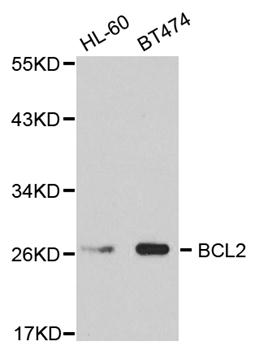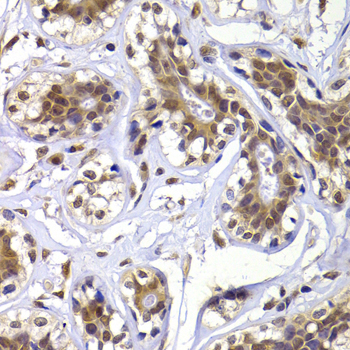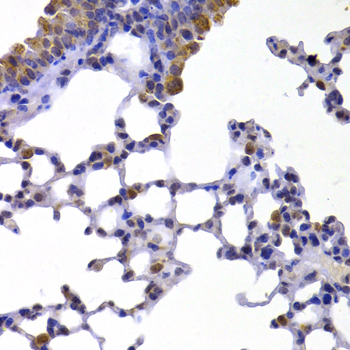Product Name :
BCL2 polyclonal antibody Background :
Bcl-2 is one among many key regulators of apoptosis which are essential for proper development, tissue homeostasis and protection against foreign pathogens. Human Bcl-2 is a 26 kDa, membraneassociated, anti-apoptotic oncoprotein that can promote cell survival through protein-protein interactions with other Bcl-2 related family members, such as the death suppressors Bcl-xL, Mcl-1, Bcl-w and A1, or the death agonists Bax, Bak, Bik, Bad and BID. The anti-apoptotic function of Bcl-2 can also be regulated through proteolytic processing and phosphorylation. Bcl-2 may promote cell survival by interfering with the activation of the cytochrome c/Apaf-1 pathway through stabilization of the mitochondrial membrane. Product :
Rabbit IgG, 1mg/ml in PBS with 0.02% sodium azide, 50% glycerol, pH7.2 Storage&Stability :
Store at 4°C short term. Aliquot and store at -20°C long term. Avoid freeze-thaw cycles. Specificity :
BCL2 polyclonal antibody detects endogenous levels of BCL2 protein. Immunogen :
A synthetic peptide of human BCL2. Conjugate :
Unconjugated Modification :
Unmodification
BCL2 polyclonal antibody Background :
Bcl-2 is one among many key regulators of apoptosis which are essential for proper development, tissue homeostasis and protection against foreign pathogens. Human Bcl-2 is a 26 kDa, membraneassociated, anti-apoptotic oncoprotein that can promote cell survival through protein-protein interactions with other Bcl-2 related family members, such as the death suppressors Bcl-xL, Mcl-1, Bcl-w and A1, or the death agonists Bax, Bak, Bik, Bad and BID. The anti-apoptotic function of Bcl-2 can also be regulated through proteolytic processing and phosphorylation. Bcl-2 may promote cell survival by interfering with the activation of the cytochrome c/Apaf-1 pathway through stabilization of the mitochondrial membrane. Product :
Rabbit IgG, 1mg/ml in PBS with 0.02% sodium azide, 50% glycerol, pH7.2 Storage&Stability :
Store at 4°C short term. Aliquot and store at -20°C long term. Avoid freeze-thaw cycles. Specificity :
BCL2 polyclonal antibody detects endogenous levels of BCL2 protein. Immunogen :
A synthetic peptide of human BCL2. Conjugate :
Unconjugated Modification :
Unmodification
-
 Western blot analysis of extracts of various cell lines using BCL2 antibody.
Western blot analysis of extracts of various cell lines using BCL2 antibody. -
 Immunohistochemistry of paraffin-embedded human breast using BCL2 antibody at dilution of 1:100 (x40 lens).
Immunohistochemistry of paraffin-embedded human breast using BCL2 antibody at dilution of 1:100 (x40 lens). -
 Immunohistochemistry of paraffin-embedded human breast using BCL2 antibody at dilution of 1:100 (x40 lens).
Immunohistochemistry of paraffin-embedded human breast using BCL2 antibody at dilution of 1:100 (x40 lens).
miR-4293 upregulates lncRNA WFDC21P by suppressing mRNA-decapping enzyme 2 to promote lung carcinoma proliferation
PMCID: Pubmed No.:34301920
Exosomal miR-1910-3p promotes proliferation, metastasis, and autophagy of breast cancer cells by targeting MTMR3 and activating the NF-κB signaling pathway
PMCID: Pubmed No.:32531321
Long non-coding RNA ESCCAL-1 promotes esophageal squamous cell carcinoma by down regulating the negative regulator of APOBEC3G
PMCID: Pubmed No.:32905814
Growth arrest and apoptosis induction in androgen receptor-positive human breast cancer cells by inhibition of USP14-mediated androgen receptor deubiquitination
PMCID: Pubmed No.:29353883
Potent effects of dioscin against hepatocellular carcinoma through regulating TP53‐induced glycolysis and apoptosis regulator (TIGAR)‐mediated apoptosis, autophagy, and DNA damage
PMCID: Pubmed No.:30710454
Luteolin ameliorates rat myocardial ischaemia–reperfusion injury through activation of peroxiredoxin II
PMCID: Pubmed No.:29782637
A Protein from Dioscorea polystachya (Chinese Yam) Improves Hydrocortisone-Induced Testicular Dysfunction by Alleviating Leydig Cell Injury via Upregulation of the Nrf2 Pathway
PMCID: Pubmed No.:34887997
Deubiquitination and stabilization of estrogen receptor α by ubiquitin-specific protease 7 promotes breast tumorigenesis
PMCID: Pubmed No.:31518603
The circadian clock gene Bmal1 facilitates cisplatin-induced renal injury and hepatization
PMCID: Pubmed No.:32522976
Piperazine-Derived α1D/1A Antagonist 1- Benzyl-N- (3-(4- (2-Methoxyphenyl) Piperazine-1-yl) Propyl) -1H- Indole-2- Carboxamide Induces Apoptosis in Benign Prostatic Hyperplasia Independently of α1-Adrenoceptor Blocking
PMCID: Pubmed No.:33584271
Pyridostigmine Protects Against Diabetic Cardiomyopathy by Regulating Vagal Activity, Gut Microbiota, and Branched-Chain Amino Acid Catabolism in Diabetic Mice
PMCID: Pubmed No.:34084135
Pyridostigmine alleviates cardiac dysfunction via improving mitochondrial cristae shape in a mouse model of metabolic syndrome
PMCID: Pubmed No.:30633969
Fruiting body polysaccharides of Hericium erinaceus induce apoptosis in human colorectal cancer cells via ROS generation mediating caspase-9-dependent signaling pathways
PMCID: Pubmed No.:32573644
A novel drug-free strategy of nano-pulse stimulation sequence (NPSS) in oral cancer therapy: In vitro and in vivo study
PMCID: Pubmed No.:29719274
Reversal Effects of Bound Polyphenol from Foxtail Millet Bran on Multidrug Resistance in Human HCT-8/Fu Colorectal Cancer Cell
PMCID: Pubmed No.:29730933
Kaempferol Reverses Aerobic Glycolysis via miR-339-5p-Mediated PKM Alternative Splicing in Colon Cancer Cells
PMCID: Pubmed No.:33663206
Kaempferol Reverses Aerobic Glycolysis via miR-339-5p-Mediated PKM Alternative Splicing in Colon Cancer Cells
PMCID: Pubmed No.:33663206
Targeting PI3K/Akt/Nrf2 pathway by glabridin alleviates acetaminophen-induced hepatic injury in rats
PMCID: Pubmed No.:33932887
Histone deacetylase 8 inhibition alleviates cholestatic liver injury and fibrosis
PMCID: Pubmed No.:33130126
The RhoA/ROCK pathway mediates high glucose-induced cardiomyocyte apoptosis via oxidative stress, JNK, and p38MAPK pathways
PMCID: Pubmed No.:29745021
The loss of dopaminergic neurons in DEC1 deficient mice potentially involves the decrease of PI3K/Akt/GSK3β signaling
PMCID: Pubmed No.:31884423
HucMSC exosome-delivered 14-3-3ζ alleviates ultraviolet radiation-induced photodamage via SIRT1 pathway modulation
PMCID: Pubmed No.:33882455
Toosendanin Shows Potent Efficacy Against Human Ovarian Cancer through Caspase-Dependent Mitochondrial Apoptotic Pathway
PMCID: Pubmed No.:34521317
Crocin ameliorates arsenic trioxide‑induced cardiotoxicity via Keap1-Nrf2/HO-1 pathway: Reducing oxidative stress, inflammation, and apoptosis
PMCID: Pubmed No.:32920515
Exosomes derived from autologous dermal fibroblasts promote diabetic cutaneous wound healing through the Akt/β-catenin pathway
PMCID: Pubmed No.:33685347
A pentacyclic triterpene derivative possessing polyhydroxyl ring A suppresses growth of HeLa cells by reactive oxygen species-dependent NF-κB pathway
PMCID: Pubmed No.:30153443
The neuroprotective effect of phillyrin in intracerebral hemorrhagic mice is produced by activation of the Nrf2 signaling pathway
PMCID: Pubmed No.:34425100
Heat‐Shock protein A12A is a novel PCNA‐binding protein and promotes hepatocellular carcinoma growth
PMCID: Pubmed No.:32128976
Constitutive activity of GPR26 regulated by ubiquitin‐dependent degradation and its antitumor role
PMCID: Pubmed No.:33577134
Histone Deacetylase Inhibitor Alleviates the Neurodegenerative Phenotypes and Histone Dysregulation in Presenilins-Deficient Mice
PMCID: Pubmed No.:29867447
Integrating bioinformatics with pharmacological evaluation for illustrating the action mechanism of herbal formula Jiao'e mixture in suppressing lung carcinoma
PMCID: Pubmed No.:34400263
Diterpene Ginkgolides Meglumine Injection inhibits apoptosis induced by optic nerve crush injury via modulating MAPKs signaling pathways in retinal ganglion cells
PMCID: Pubmed No.:34181957
Hederagenin Attenuates Cerebral Ischaemia/Reperfusion Injury by Regulating MLK3 Signalling
PMCID: Pubmed No.:32848779
Effect of Glycyrrhiza uralensis against ulcerative colitis through regulating the signaling pathway of FXR/P-gp
PMCID: Pubmed No.:34540046
Protective effects of Salidroside on cardiac function in mice with myocardial infarction
PMCID: Pubmed No.:31792327
Comparison of the sensitivity of Western blotting between PVDF and NC membranes
PMCID: Pubmed No.:34103620
The biphasic effects of the oxLDL/β2GPI/anti-β2GPI complex on VSMC proliferation and apoptosis
PMCID: Pubmed No.:30738928
Profiles of messenger RNAs and MicroRNAs in hypoxia-induced hepatic stellate cells
PMCID: Pubmed No.:34734003
LncRNA-GAS5 promotes spinal cord repair and the inhibition of neuronal apoptosis via the transplantation of 3D printed scaffold loaded with induced pluripotent stem cell-derived neural stem cells
PMCID: Pubmed No.:34350246
Vitamin D3 supplementation improves testicular function in diabetic rats through peroxisome proliferator‐activated receptor‐γ/transforming growth factor‐beta 1/nuclear factor‐kappa B
PMCID: Pubmed No.:29953732
Prodromal Alzheimer’s Disease: Constitutive Upregulation of Neuroglobin Prevents the Initiation of Alzheimer’s Pathology
PMCID: Pubmed No.:33343276
The novel GLP-1/GIP dual agonist DA3-CH is more effective than liraglutide in reducing endoplasmic reticulum stress in diabetic rats with cerebral ischemia-reperfusion injury
PMCID: Pubmed No.:33500109
Ursolic acid induces apoptosis and anoikis in colorectal carcinoma RKO cells
PMCID: Pubmed No.:33549076
(−)-Epigallocatechin Gallate (EGCG) Enhances the Sensitivity of Colorectal Cancer Cells to 5-FU by Inhibiting GRP78/NF-κB/miR-155-5p/MDR1 Pathway
PMCID: Pubmed No.:30741544
Luteolin attenuates high glucose-induced podocyte injury via suppressing NLRP3 inflammasome pathway
PMCID: Pubmed No.:30935950
Epidermal growth factor‐containing fibulin‐like extracellular matrix protein 1 (EFEMP1) suppressed the growth of hepatocellular carcinoma cells by promoting Semaphorin 3B(SEMA3B)
PMCID: Pubmed No.:30972979
LncRNA SNHG6 Inhibits Apoptosis by Regulating EZH2 Expression via the Sponging of MiR-101-3p in Esophageal Squamous-Cell Carcinoma
PMCID: Pubmed No.:33192074
Echinocystic acid provides a neuroprotective effect via the PI3K/AKT pathway in intracerebral haemorrhage mice
PMCID: Pubmed No.:32055597
Echinocystic acid, a natural plant extract, alleviates cerebral ischemia/reperfusion injury via inhibiting the JNK signaling pathway
PMCID: Pubmed No.:31425684
Glucagon-like peptide-1/glucose-dependent insulinotropic polypeptide dual receptor agonist DA-CH5 is superior to exendin-4 in protecting neurons in the 6-hydroxydopamine rat Parkinson model
PMCID: Pubmed No.:33433498
Rosmarinic acid elicits neuroprotection in ischemic stroke via Nrf2 and heme oxygenase 1 signaling
PMCID: Pubmed No.:30323140
RNPS1 inhibition aggravates ischemic brain injury and promotes neuronal death
PMCID: Pubmed No.:31831174
Streptolysin O derived from Streptococcus pyogenes inhibits RANKL‑induced osteoclastogenesis through the NF‑κB signaling pathway
PMCID: Pubmed No.:30431141
Mitochondrial targeting of TR3 is involved in TPA induced apoptosis in breast cancer cells
PMCID: Pubmed No.:30641217
Macrophages activate mesenchymal stem cells to acquire cancer‑associated fibroblast‑like features resulting in gastric epithelial cell lesions and malignant transformation in vitro
PMCID: Pubmed No.:30655826
-Hederin Arrests Cell Cycle at G2/M Checkpoint and Promotes Mitochondrial Apoptosis by Blocking Nuclear Factor-B Signaling in Colon Cancer Cells
PMCID: Pubmed No.:30363706
The novel GLP-1/GIP dual receptor agonist DA3-CH is neuroprotective in the pilocarpine-induced epileptogenesis rat model
PMCID: Pubmed No.:31121474
Post-treatment with the GLP-1 analogue liraglutide alleviate chronic inflammation and mitochondrial stress induced by Status epilepticus
PMCID: Pubmed No.:29549796
Semaglutide-mediated protection against Aβ correlated with enhancement of autophagy and inhibition of apotosis
PMCID: Pubmed No.:33222922
Effect of Oleanolic Acid on Apoptosis and Autophagy of SMMC-7721 Hepatoma Cells
PMCID: Pubmed No.:32424110
Expression of brain-derived neurotrophic factor in kidneys from normal and cyclosporine-treated rats
PMCID: Pubmed No.:29540150
Effects of claudin‑1 downregulation on the physiological processes of gallbladder cancer SGC996 cells
PMCID: Pubmed No.:30675228
Vildagliptin, a DPP4 inhibitor, alleviates diabetes‑associated cognitive deficits by decreasing the levels of apoptosis‑related proteins in the rat hippocampus
PMCID: Pubmed No.:29805536
Ethanol Extract of Hizikia fusiforme Induces Apoptosis in B16F10 Mouse Melanoma Cells through ROS-Dependent Inhibition of the PI3K/Akt Signaling Pathway
PMCID: Pubmed No.:32458633
Quercetin protects human liver cells from o,p’-DDT-induced toxicity by suppressing Nrf2 and NADPH oxidase-regulated ROS production
PMCID: Pubmed No.:35122929
Mechanism of Shiliu Buxue Syrup for anemia using integrated metabolomics and network pharmacology
PMCID: Pubmed No.:35690102
IL-27 regulates autophagy in rheumatoid arthritis fibroblast-like synoviocytes via STAT3 signaling
PMCID: Pubmed No.:35820245
Functional recovery of myocardial infarction by specific EBP-PR1P peptides bridging injectable cardiac extracellular matrix and vascular endothelial growth factor
PMCID: Pubmed No.:36579729
Delivery of miR-3529-3p using MnO2-SiO2-APTES nanoparticles combined with phototherapy suppresses lung adenocarcinoma progression by targeting HIGD1A
PMCID: Pubmed No.:36808485
Bioworld Biotech only provide peptides for our antibodies and do not provide additional peptide customization services.
Price/Size :
USD 368/1mg/vial
Tips:
For phospho antibody, we provide phospho peptide(0.5mg) and non-phospho peptide(0.5mg).Describe :
Blocking peptides are peptides that bind specifically to the target antibody and block antibody binding. These peptide usually contains the epitope recognized by the antibody. Antibodies bound to the blocking peptide no longer bind to the epitope on the target protein. This mechanism is useful when non-specific binding is an issue, for example, in Western blotting (WB) and Immunohistochemistry (IHC). By comparing the staining from the blocked antibody versus the antibody alone, one can see which staining is specific; Specific binding will be absent from the western blot or IHC performed with the neutralized antibody.Formula:
Synthetic peptide was lyophilized with 100% acetonitrile and is supplied as a powder. Reconstitute with 0.1 ml DI water for a final concentration of 10 mg/ml.The purity is >90%,tested by HPLC and MS.
Storage:
The freeze-dried powder is more stable. For short time at 2-8°C. For long term storage store at -20°C.
Note :
This product is for research use only (RUO only). Not for use in diagnostic or therapeutic procedures.
 BCL2 polyclonal antibody
BCL2 polyclonal antibody  Datasheet
Datasheet COA
COA MSDS
MSDS SHIP
SHIP